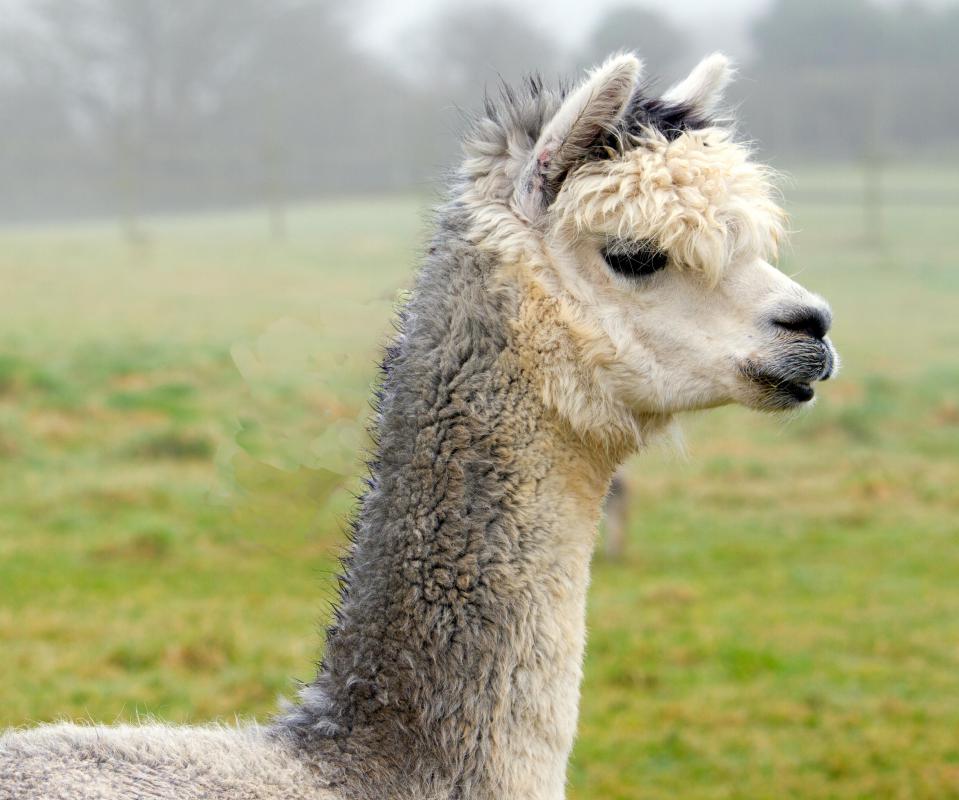At AllThingsNature, we're committed to delivering accurate, trustworthy information. Our expert-authored content is rigorously fact-checked and sourced from credible authorities. Discover how we uphold the highest standards in providing you with reliable knowledge.
What is an Alpaca?
The alpaca is an animal related to the llama. Alpacas are the domesticated form of the guanaco, a South American wild animal that roams the mountain slopes of the Andes in Ecuador, Peru, Bolivia and Chile.
The alpaca looks like a long-haired, shaggy llama, with thick, soft wool that covers its eyes and often drags on the ground beneath its body. Alpacas are gentle animals that are agreeable with people, hearty to raise, and easy to transport. They live about 20 years, stand about 3 feet (1 meter) in height, and weigh between 100 and 200 pounds (45-90 kg.). Much like cows or sheep, they graze on grasses and chew a cud. Alpaca reproduction is fairly trouble-free and gestation is between 11 and 12 months.

Alpacas originally played an important role in the ancient Incan culture where they were treasured for their soft fleece that was worn only by Incan royalty. Large herds of alpacas high in the mountain villages of the Andes were seen as a sign of great wealth and good fortune. Having been established as the primary source of income for a large part of the South American population in recent centuries, the alpaca was first brought to the United States in 1984.

Today alpacas have become a much loved investment for American farmers, animal lovers and investors. The fleece from an alpaca is similar to wool or mohair, but it is softer and silkier and takes much longer to grow; thus it is quite expensive and in high demand. The fleece is shorn from the alpaca much like sheep's wool, without harming the animal in any way, then sold to fashion hubs around the world to be made into the finest garments. Between the two types of alpacas: the Huacaya and the Suri, fleece is available in more than 20 different colors. Softer than cashmere and lighter, stronger and warmer than wool, alpaca fleece is a luxurious commodity that produces lightweight, warm clothing.
Alpaca owners have the option to be members of the AOBA (the Alpaca Owners and Breeders Association), which provides information and addresses all aspects of the alpaca fleece industry. Owners may also join the AFCNA (the Alpaca Fiber Cooperative of North America) which gives members with the opportunity to turn their alpaca fleece into clothing and other products. Owners will also want to be part of the Alpaca Registry, in which every alpaca is documented by breeding and bloodlines.
Frequently Asked Questions
What is an alpaca and where do they originate from?
Alpacas are domesticated members of the camelid family, native to the Andean mountain range of South America. They are closely related to llamas and were first domesticated by the indigenous people of the region thousands of years ago for their luxurious fleece, which is prized for its softness, warmth, and hypoallergenic qualities.
How do alpacas differ from llamas?
Alpacas are often confused with llamas, but they have distinct differences. Alpacas are smaller, weighing between 100 to 200 pounds, while llamas can weigh up to 400 pounds. Alpacas have finer, more luxurious fleece, which is used for high-quality textiles. Llamas, on the other hand, have coarser outer coats and were traditionally used as pack animals and for their meat.
What are the different types of alpaca fleece?
There are two primary types of alpaca fleece: Huacaya and Suri. Huacaya fleece is dense, crimped, and woolly, giving a fluffy appearance, while Suri fleece grows in long, silky locks that hang down and have a lustrous sheen. Both types are highly valued in the textile industry for their unique properties.
What is the lifespan of an alpaca and how do they behave?
Alpacas typically live for about 15 to 20 years. They are social herd animals that prefer the company of their kind and communicate through body language and soft humming sounds. Alpacas are known for their gentle and curious nature, making them popular among farmers and animal enthusiasts alike.
How are alpacas beneficial to humans?
Alpacas are primarily raised for their fiber, which is sheared annually and turned into various high-quality garments and textiles. Their manure is also an excellent, eco-friendly fertilizer. Additionally, alpacas are increasingly used in animal-assisted therapy due to their calming presence and gentle demeanor.
What does alpaca diet and care involve?
Alpacas are herbivores with a diet consisting mainly of grass, hay, and low-protein feed supplements. They require fresh water and adequate pasture for grazing. Alpaca care includes regular shearing, vaccinations, deworming, and dental and hoof care. With proper management, they can thrive in various climates, from their native Andean highlands to farms worldwide.
AS FEATURED ON:
AS FEATURED ON:












Discussion Comments
I've recently acquired my grandmother's silver set and other items. I know they were stationed in Germany during World War II, which is where most of her belongings are from. One cream says Alpaka with a K instead of a C. What is this?
It is generally now accepted that the alpaca is at partially a descendant of the wild vicuna rather than exclusively from the guanaco. See "Evolution and Origin of the Domestic Camelids" by Jane C. Wheeler, PhD.
Post your comments